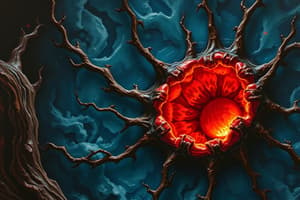Podcast
Questions and Answers
Which type of cell death is characterized by widespread peroxidation of lipids?
Which type of cell death is characterized by widespread peroxidation of lipids?
- Apoptosis
- Necroptosis
- Pyroptosis
- Ferroptosis (correct)
What is a common feature of pyroptosis?
What is a common feature of pyroptosis?
- Presence of apoptotic bodies
- Caspase-independent cell death
- Prevention by iron-chelation
- Release of interleukin 1 (correct)
Which necrosis type is often associated with a bacterial infection resulting in liquid formation?
Which necrosis type is often associated with a bacterial infection resulting in liquid formation?
- Fibrinoid necrosis
- Liquefactive necrosis (correct)
- Enzymatic fat necrosis
- Coagulative necrosis
In the context of necroptosis, what describes the relationship with inflammation?
In the context of necroptosis, what describes the relationship with inflammation?
Which of the following is characteristic of saponification in necrosis?
Which of the following is characteristic of saponification in necrosis?
What is the primary consequence of mitochondrial damage in relation to apoptotic pathways?
What is the primary consequence of mitochondrial damage in relation to apoptotic pathways?
Which of the following correctly identifies a microscopic change associated with apoptosis?
Which of the following correctly identifies a microscopic change associated with apoptosis?
What happens when apoptosis pathways are defective?
What happens when apoptosis pathways are defective?
Which process is characterized by the fragmentation of the nucleus during apoptosis?
Which process is characterized by the fragmentation of the nucleus during apoptosis?
Which of the following statements best differentiates apoptosis from necrosis?
Which of the following statements best differentiates apoptosis from necrosis?
Flashcards are hidden until you start studying
Study Notes
Necrosis
- Liquefactive necrosis is characterized by bacterial infection and saponification.
- Pyroptosis is a type of programmed cell death characterized by the release of inflammatory mediators, such as IL-1, resulting in inflammation and fever.
- Ferroptosis is a type of programmed cell death characterized by peroxidation of lipids and is prevented by iron chelation.
- Coagulative necrosis is characterized by denaturation of proteins which blocks proteolysis, thus, preserving the architecture of dead tissues.
Apoptosis
- Activation of apoptotic pathways is a direct consequence of mitochondrial damage.
- Cell shrinkage is a characteristic of apoptosis.
- Apoptosis is a process of programmed cell death and can lead to accumulation of misfolded proteins, observed in embryogenesis, and apoptosis of cells that have served their purpose.
- Defective apoptosis leads to increased cell survival and increased cell death rate.
Inflammation & Thrombosis
- Gangrenous necrosis is characterized by ischemia followed by coagulative necrosis.
- Fibrinoid necrosis is characterized by deposition of antigen-antibody complexes and immune reactions.
- Hyperemia is an active process resulting in erythematous appearance of tissues.
- Thrombosis is a process of blood clot formation and is regulated by balance between anticoagulant and procoagulant activities of endothelium.
- Antithrombotic properties of endothelium include:
- Inhibition of platelet activation and aggregation by PGI2, NO, and ADP.
- Inhibition of coagulation factor VIIa by thrombomodulin.
- Activation of Protein C & S by thrombomodulin.
- Direct inhibition of tissue factor VIIa and Xa by cell surface protein.
- Activation of fibrinolysis to clear fibrin by t-PA
- Procoagulant properties of endothelium include:
- Release of von Willebrand factor (vWF) by endothelial cells.
- Exposure of collagen by damaged endothelium.
- Antithrombotic properties of endothelium include:
- Hemorrhage is a blood leak and can present as petechiae, purpura, or ecchymosis.
### Other
- Pyknosis is characterized by condensation of chromatin into a solid, shrunken basophilic mass.
- Karyolysis is characterized by liquefaction of chromatin.
- Karyorrhexis is characterized by fragmentation of chromatin.
- Inability to reverse mitochondrial damage signifies the point of no return in cell injury.
Studying That Suits You
Use AI to generate personalized quizzes and flashcards to suit your learning preferences.





